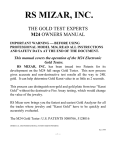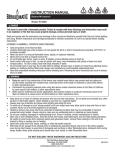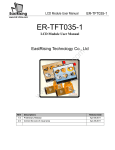Download Laser Maintenance Schedule .. PDF.
Transcript
Rabbit Laser USA.com Maintenance Schedule (When to clean ... When to oil ... When to do stuff to keep it working nice.) Focal lens: This is the lens that is used to focus the laser beam. This lens should be cleaned at least once per week. It is not possible to clean the lens while it is mounted in the focal tube. The laser beam alignment should be checked after cleaning is completed. If there is any incident of fire or large issue of smoke/fumes, then it is advised to check the lens and clean it. Use denatured alcohol and/or acetone as the cleaning solvent. Use a lens tissue or cotton tipped swabs (Qtips) to apply the solvent. Do not scrape the lens... Use the solvent to dissolve the dirt from the lens surface. Only use a soft swirling motion when applying the solvent. Use a dry swab in soft swirling motion while evaporating the solvent. Use as many swabs as needed to result in a clean lens surface. The lens surface should be somewhat difficult to see. Look at a reflection in the lens to help see dirt on the surface. Make sure to clean the lens and not leave water marks or dirt smears. The focal lens should be replaced if it is cracked, the coating is scratched/pitted, the core material is darkened, the coating is delaminating, or any other significant damage is found. Some minor blemishes are acceptable, but these problems waste power and will result in reduced laser power at the target material. Any dirt, contaminate, or damage to the lens will cause the lens to become damaged faster. Mirror #3: This mirror is located directly above the focal lens. This mirror should be cleaned at least every one month. If there is any incident of fire or large issue of smoke/fumes, then it is advised to check the mirror and clean it. It is possible to clean the mirror in its' mounting bracket, but highly advised to remove the mirror from position and thoroughly clean it. The laser beam alignment should be checked after cleaning is completed. Use denatured alcohol and/or acetone as the cleaning solvent. Use a lens tissue or cotton tipped swabs (Qtips) to apply the solvent. Do not scrape the lens... Use the solvent to dissolve the dirt from the lens surface. Only use a soft swirling motion when applying the solvent. Use a dry swab in soft swirling motion while evaporating the solvent. Use as many swabs as needed to result in a clean surface. The mirror surface should be difficult to see. Look at a reflection in the mirror to help see dirt on the surface. Make sure to clean the lens and not leave water marks or dirt smears. The mirror should be replaced if it is pitted/scratched, rusted, discolored from heat damage, or any other significant damage is found. Some minor blemishes are acceptable, but these problems waste laser power and will result in reduced laser power at the target material. Any dirt, contaminate, or damage on the mirror will cause the mirror to become damaged faster. Mirror #2: This mirror is located directly at the end of the gantry rail. This mirror should be cleaned at least every two months. Use the same directions as found for mirror#3 Mirror #1: This mirror is located directly in front of the laser tube. This mirror should be cleaned at least every three months. Use the same directions as found for mirror#3 Laser tube output coupler lens: This lens is located inside the output end of the laser tube. This lens should be cleaned at least every three months. You must be very careful when cleaning this lens. This lens cannot be removed from the laser tube. You can use a Q-tip for applying the acetone. Be gentle. The ideal situation is that you are only removing dust, film contaminate from humidity, or smoke fumes. Do not scratch this lens.. It is not replaceable. Linear rails: The linear rails are the guiding rails along the left and right sides, and across the gantry. these rails should be clean, without rust, and have a slight glaze coating of some oil. The linear rails should be given some attention about every month. The surfaces of the metal should always have oil on it such that it is wet to the touch. The best way to see that you need to do some cleaning is to check the end of the rail near where the home switch is located. If you see a dirt line, then clean the rails off and apply fresh oil. Linear bearings: The linear bearings are found under the gantry(to mount the gantry to the side rails) and under the focal head(to mount the focal head to the gantry). These bearings have grease fittings for pushing lubricant into the ball bearing areas. You might not have a special grease pump to lubricate the bearings. Try the cheap and easy approach. 1) Remove the grease fitting, 2) Apply the grease to your finger, 3) Push the grease into the little hole, 4) push more grease into the little hole, 5) go to step #2 ..... 6) Put the grease fitting back on. Rubber belts: The rubber belts should be checked for appropriate tension at least every six months. You should expect the two side belts to be the same tension and should be tensioned at the same maintenance schedule. These side belts work together to move the gantry from front to rear. If one belt is tensioned more often than another, then that belt could become stretched more than the other. It is difficult to describe how tight the belts should be, but there should not be a slack, sagging, or flapping. If the belt appears to be worn on one side, check the bearing alignment or damage to the matching bearings. There are many laser machine designs, but the method of changing the belt tension should not be too complex. It is normally a method of tightening a screw and then applying a lock nut to keep the screw in place. Fans: The cooling fans are used to force air over the electrical parts of the laser machine control system. If a fan blades get dirty, then that fan cannot move the air as quickly. We need to check the fans to see if our laser environment is not so clean as we hoped. If the fan blades are dirty, then we can clean the blades with a spray bottle of alcohol, q-tips, and some paper towels. It is best to clean fans with the power turned off.... Not spinning. Air filters: Please consult your user appropriate user manual(s) for cleaning or replacing the air filters. Air filters work best when air is able to move through them and catch the specs of dust, fumes, and other crap in the air. If a filter is too dirty, then the air pressure will be adversely reduced. It can be very important to get the bad smells out of the room. Some off-gasses from the laser cutting process can be caustic, nauseating, volatile, corrosive, or even deadly. It is best to use multiple stages of filters to catch the different sizes of of particles. Exhaust flange screen: Many people forget about the screens in the exhaust system. Your exhaust system could have a few screens. Some screens are there to protect the exhaust blower from small chunks of scrap material coming from the laser. We don't want the chunks of scrap materials to get sucked into the blower fan blades. Some screens are there to protect the exhaust system from animals wanting a warm place to build a home (until the off-gas of PVC kills them). The screens are often located at wall exiting the building, prior to entering a filter device, at the exit of the laser machine. The biggest issue of forgetfulness is regarding the small chunks of wood, styrofoam, or other materials. These pieces clog up the screens and greatly reduce the air flow. The reduced air flow means that the smell of cut acrylic, ABS, or whatever stays in the laser machine. The exhaust system just can't do it's job any more. If you notice that the exhaust system suddenly isn't working as we'll as it used to, then you might want to check the screens. A shop vac works nicely. Don't be tempted to remove the screens. They are there for a reason. Jack screws: The jack screws are like threaded rods that are used to elevate the work surface. Most all laser machines have a work table that is motorized. The jack screws should be greased when assembled at the factory. Additional grease can be applied if desired, but is not likely to be needed more than every few years. Chains: A chain is sometimes used to synchronize the turning of the jack screws. The chain will be woven from the Zaxis motor shaft around the sprockets at each of the jack screws. The chain should be greased when the laser machine was assembled at the factory. Additional grease can be applied if desired, but is not likely to be needed. Z-axis touch sensor: The Z-axis distance sensor is used during the auto-focus routine. There are many designs of the z-axis distance sensor. Most designs use a probe to touch the top of the engrave/cut surface. This allows the sensor to react to the target material and then apply the right distance between the focal lens and the target material. do we care if the touch probe is dirty? The concern is that you don't want the sensor to get your material dirty...and you want the sensor to accurately position your focus distance. Nuts/bolts : If concerned about these items rusting, then you should apply a thin coating of silicone-base grease. One application per year should be enough. Coolant: Firstly, automotive antifreeze should not be used as a laser coolant. The best coolant is deionized water. In the absence of deionized water, distilled water can be used. Tap water should be a much later resort. The coolant should always be clean and clear. It is a common problem for the coolant to become infested with mold. This often looks like a murky green water with snot building up on the inner walls of the hoses. The solution is a mutli-step process. * Flush out the bad water *Add fresh water with 20 percent bleach . Cycle the bleach-water for 30 minutes. Flush this water out also. *Switch the inlet and outlet hoses and flush with more water. This should dislodge mold from inside the laser tube. * The flow safety sensor could also be full of mold... The best solution is to take it apart and clean with a soft brush or pipe cleaners. Make sure to re-assemble the sensor correctly and without leaks. It is possible that harsh cleaners could creep into the sensor electronics and cause permanent damage. Storage of the laser: Clean, dry, warm... No vibration. Use a heater: If your laser is expected to be exposed to temperatures below 50 degrees Fahrenheit, then use a heater. The laser machine is a significant investment and should be kept warm. It is easy to put a ceramic space heater inside the laser machine with the temperature set to something moderate. The heat will move throughout the inside of the laser and keep the glass laser tube warm enough to not freeze or crack. A sudden shock of icy cold water rushing into the warm glass can break the glass laser tube. What to do about the water pump, bucket, or chiller? You have a few options. 1) Use an aquarium heater to warm the water. Set the temperature to a moderate level. The water in the hoses could still freeze. Use a simple timer switch to turn the water pump on/off every fifteen minutes. 2) If you are worried about wasting the life of your water pump, then drain the laser coolant from the entire system. Disconnect the hoses from the laser machine. Use an air compressor to blow out as much water as you can (Blow air into the hose that water comes out of the laser machine. This should clear out the most water). Take the chiller to somewhere that will not freeze. Put a heater inside the laser machine. 3) Move the laser machine system to somewhere warm. Use a dehumidifier : Humidity can cause the metal parts of the laser machine to rust. All metal is expected to rust. One unexpected metal surface is the laser mirrors. It is best to try to control the humidity level in the laser work area. Clean the mirrors and check for this oxidation as a possible problem. Replace mirrors that do not meet your expectation of performance. Make a maintenance schedule: The easiest way to follow a cleaning schedule is to buy a calendar and write on the dates that you want to do the maintenance. Some maintenance is needed on a regular basis while other cleaning could be an immediate requirement after a disaster. Just know that avoiding the maintenance of your laser could result such that the laser doesn't work right ...or doesn't work at all.















